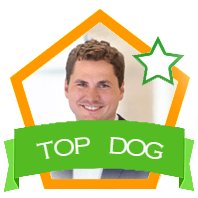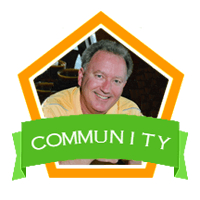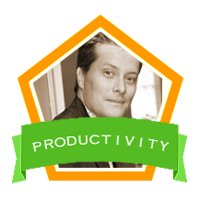So, as always, D2L’s Fusion conference is a good time. I always learn a lot, but I always have a good time as well. Usually, I like to fly out of Buffalo airport, but the way things worked out I was flying out of Toronto Island Airport (not Pearson, which is the big one that most people use). It was a great experience, but different. I am always really early for flights, and prefer to pay in cash, and at Toronto Island you don’t have to be two hours ahead, and you can’t pay for anything in cash. Oh well, I’ll know for next time. I did run into a ton of people who were going to the conference, including people from Ryerson University, Conestoga College, and the University of Guelph. Jason, a co-conspirator in provocative thinking (or a troublemaker and a friend), was on the plane, and gave me the best compliment on my readiness to get through customs; “you’re such an organized anarchist”.
I knew this year’s conference was going to be a get-up and go quickly kind of affair; the whole deal itself started on the Sunday night, so I had a whole of 6/7 hours before it started to get in some record shopping, a meal, and maybe see a sight or two (I don’t really sight see, I’ve been to New York City half a dozen times and have never gone to the Statue of Liberty, seen a Broadway play or gone up the Empire State Building). Having never been in DC, I scoped out their record store selection (in hindsight Joint Custody was the best of the bunch, but none of them were what I’d call “bad”) realized it all stemmed from U street, and head off that way. I didn’t really get a chance to hunt down some Go Go, but that was due to a lack of time. After a stop at Ben’s Chili Bowl (doubling for my sightseeing and a meal, because the importance of the restaurant cannot be understated) for a half-smoke (no onions) and a bit of history, records scored, it was time to get back to the hotel, and get situated for the evening conference welcome.
The conference welcome started, I ran into Barry, who I have this kinship with, so we typically hang out as much as possible (which isn’t as much as I’d like) when you consider the scope of this sort of thing. Also getting odd photos with former Premier of Ontario seems to be a thing for me:
After a brief night out, I returned to the hotel, and noticed that I had missed shaving a chunk of hair on the side of my head right above my ear. How did I go through the whole day, talking to people I know, in two different states and a province, with no one saying, “hey, your barber missed a spot”? At a quarter to midnight it was off to the 24 hour CVS to get some disposable razors. My friends are a bunch of jerks. OK, not really. It also allowed me to catch a ton of Pokemon on my stroll, so it was all for good.
Day One
For whatever reason, perhaps it’s my inner competitor, I always like playing D2L’s event games. This year’s app was well built and a neat motivator for me to fill in feedback. I know, judging from how many people stuck around for codes at the end of the presentations, that I’m not the only one.
I was early for the breakfast (getting up at 6 AM for some ungodly reason), so I wandered around the vendor displays and talked to Kaltura and ReadSpeaker about their products (Kaltura we have as a streaming solution for our department needs, ReadSpeaker we have looked at for a while but haven’t had any group on campus suggest they want to foot the bill for).
The opening remarks were good enough – sales pitch for how good D2L is really – but that’s to be expected. I was really interested to hear about some of the success stories that D2L has had over the last year in different areas of the world and education sector. It seems that they’re really pushing into the corporate training space, and an LMS (especially when you consider the work being done in outcomes that they’re investing in) makes sense in that context. I wonder if that diversification of clients is something that will make getting higher education’s needs met harder? Will D2L spread themselves too thin? I guess we’ll find out over the next few years.
Getting Started with Brightspace Data Access
I always try to attend Valence API (now called the Application API) sessions even though I’m doing zero API work – one of these days I’ll get back to the programming stuff I used to do (just in time for my outdated skills to be even more outdated…) because there’s some need to do it. In addition to the Application API, D2L is opening up it’s Data API, so you can access the data storehouse for custom queries rather than using the Application API to periodically collect that data yourself. It only works with Brightspace Data Platform, which is hosted by Amazon Web Services. There’s still some questions floating out there about what exactly is stored in Amazon, and from this session I gather a lot of it is just transaction stuff – so the code to call the data, but not the data itself. If there are data points stored, they would have to be obfuscated. They also mentioned a Data Hub, which allows you to get data extracts (if you’re an Insights/Analytics customer first) in CSV format, so hopefully that means we can run some networking analysis on how people use the system based on extracted data.
Magic Brightspace Widgets
Again, another session that I went to that wasn’t about what I’m doing currently. This one detailed how you can use jQuery and the DOM to scale through D2L’s design of the system to create widgets that change how the entire course looks and feels. Essentially you create code in the middle – which wouldn’t work at scale – but on the course level might be useful. Some really impressive stuff – too bad I couldn’t find the Prezi online anywhere, I’d like to take another look at the examples that Ms. Milanovic at Deakin University showed.
Who’s Got Game? How Badging and Certificates Drives Learner Engagement
Matt Murphy of D2L ran this session, and I wanted to attend as I’m co-running a workshop on Tuesday about badging programs – and I wanted to see what he had to say about badges. Thankfully, he covered a lot of the groundwork about what badges are (using one of the same images I used in my slides!), when to use them and a lot of the foundational work that we didn’t have time to cover in our workshop. Big high fives to Matt for laying the groundwork for us to be able to be successful. And introducing me to Untappd, an app that documents the beers you consume.
Valence Possibilities: Demonstrating Automated Course Setup and Enrollment Applications Supporting Distributed and Centralized Curricular Models
This was an interesting session about how one university uses the API to manage course creations in creative ways (essentially copying from Master courses or Sandboxes on creation). Most of their code was in C#, so that’s not a lot of use to me, but the principles are always good to have a look at.
Keynote by Sir Ken Robinson
I will say, Sir Ken Robinson’s talk was fun, thoughtful, but lean on content. Essentially he riffed on the nature of individuality, and how creativity is a context specific idea, for an hour. An entertaining hour, yes, absolutely. I didn’t learn anything from it that I didn’t hear from his TED talks, or other sessions. I imagine he’s a great guy to get a pint with, and mull over ideas with, but this talk didn’t exactly set my heart ablaze. It was good, and maybe I was expecting that feeling the first time I saw the original TED talk about the ways systems (not just educational systems, but all systems) handle individuality (or creativity in some contexts).
A Night at the Newseum
It was cool to see a piece of the Berlin Wall. Other than that, it seemed very american-centric, and I guess that’s not really a valid criticism as it’s in Washington DC, but I was hoping for insight into how news exists elsewhere. Meh. Back to the hotel to grab a decent pint (as much as I like free beer, Amstel Light as the best beer of the bunch, requires a follow-up with something a little more full bodied) and then head up to finish up some last minute touch ups to the presentation, documents, and other stuff for the workshop tomorrow.
Day Two
Got up, did some last minute touch ups to the presentation part of the workshop for today, reviewed my bits and was early for the Technical Account Manager breakfast. Now we have good relationship with JP, or TAM, so it was neat to have some of the other TAMs around as well to see who else is one. Solution Spotlight was next, this year they announced that they’re giving YouSeeU to all their clients – although we’ll have to see where the data is hosted, what the terms of the integration are, and what the specifications of what we’re getting is. I did note, that this might impact our WebEx offering, or maybe not – depends on which product our faculty and students gravitate towards. Off to sessions.
Reimagining Portfolio Practice: An Audience Led Exploration of High Impact Portfolio Practice
Originally, this was intended to be our Learning Portfolio Program Manager co-presenting with Shane about PebblePad’s flexibility to provide portfolios of different types for different uses, but she retired and Shane from PebblePad asked me to be in the audience should there be a question about integration between D2L and PebblePad. It was a good whirlwind tour of different ways to use portfolios.
Start Your Badging Program Today!
This was the session I co-ran with Lavinia Oltean, who I often introduce as the younger, smarter, better looking, less mustachioed, more organized version of me. This may be the first time in my life I’ve left a session feeling really, really good about it. We hit all our timings (it got bumpy towards the middle) but we got through the bit of an introduction, let them get to work and we had great interaction. I think people came away with a good sense of what could be done with badges, and had a good start in working through what a badge could mean in their context.
Writing Your Own LTI + Combining It With Valence Calls = Solving Unique Problems
I missed the start of this as the end of our presentation leaked into the break and conversations were too good to abandon. The part of the session that I got was that they created a widget that used the API to create a test student account and LTI to connect their API use to Brightspace. I’m not sure why they didn’t simplify it a bit and just use the API to create and enroll the test student account (for faculty to use to view a course), but as a proof of concept it’s pretty cool.
Maximizing the Power of Brightspace: How a College is able to Generate Official course Syllabi from the Learning Environment
Again, I was late for this one as I was chatting with folks that I knew I wouldn’t see again until the next time at Fusion or at the regional conference. La Cite College have an external site that contains their course outlines, and have used the Application API (aka Valence) to read that external database and create a PDF course outline for faculty, automatically included in D2L. This was by far, the slickest idea I saw using the API at this Fusion. Really nice work.
What’s All this Buzzing About Next Generation Digital Learning Architecture?
Rob Abel from IMS Global gave a talk about how the people who help faculty learn about technology will move from an IT support sort of role, to a strategy consultant role as a result of the move from the monolithic LMS to a more distributed, next generation learning environment. His talk was wide ranging, and I’ve found it’s available here: http://demo.desire2learncapture.com/139/Watch/3688.aspx
Keynote by Angela Meiers
I only could stay for 15 minutes because the concierge suggested that we take public transit rather than a cab to the airport. Jason and I decided to go together, seeing as we’re on the same flight and need to be there at the same time. Basically, you matter is what I got from the brief time in Angela’s talk.
The Way Home..
So I admit, there were less interesting run-ins, weird moments, funny things occurring that I’m used to at a conference. And then there was the way home. It got good once we got on the express bus to Dulles. Jason got called a Tom Cruise look alike, I had to get him back on the bus when he got off at a parking lot just outside Dulles (in his defense, everyone was getting off the bus, so it seemed logical), the driver laughed at us, and we had a great chat the rest of the way.
That’s not the end of it. After clearing through TSA in what felt like record time, we were both starving and having an hour before the flight boarded, thought a meal was in order. Of course, the restaurant we choose doesn’t move fast. You’d think that perhaps airport restaurants understand some people might be in a hurry? No? Me either.
Needless to say, Jason settled up (I had cash so no need to wait!) as I ran to the gate, to get on the plane. A minute before the doors closed, he got on the plane. It was a bit of a last minute dash.



